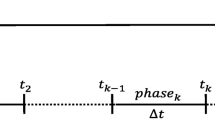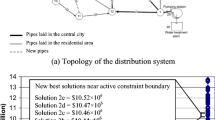Abstract
Transients are commonly triggered in urban water distribution networks (WDNs) due to daily system management and operation. While these transients are unlikely to cause catastrophic consequences immediately, frequent occurrences can result in prolonged deterioration of infrastructure safety and life cycles in the long term. To account for such impacts in the design of WDNs, a multi-objective optimization method coupled with the Non-dominated Sorting Genetic Algorithm III is proposed in this paper, where two transient-based objectives are incorporated into the WDN design process. Additionally, an engineering design constraint in the decision space is developed to ensure that the sizes of upstream pipes are not smaller than those downstream, thereby improving the engineering practicality of the optimal design solutions. Two WDN cases with transient conditions triggered by pump switching are applied to demonstrate the effectiveness of the proposed method. The results show that the widely used reliability metric based on steady-state conditions is unable to fully represent the transient impacts and that upsizing pipes can reduce transient impacts but at the expense of high economic costs. It is also found that optimally designed pipe diameters can be effective to mitigate transient impacts, in addition to the use of traditional protection devices. The proposed method represents the first step in investigating the underlying relationships between WDN design and unsteady flow effects and is a supplement to current WDN design criteria.









Similar content being viewed by others
References
Aisopou A, Stoianov I, Graham NJ (2012) In-pipe water quality monitoring in water supply systems under steady and unsteady state flow conditions: a quantitative assessment. Water Res 46(1):235–246
Boulos PF, Karney BW, Wood DJ, Lingireddy S (2005) Hydraulic transient guidelines for protecting water distribution systems. J Am Water Works Ass 97(5):111–124
Brunone B, Meniconi S, Capponi C (2018) Numerical analysis of the transient pressure damping in a single polymeric pipe with a leak. Urban Water J 15(8):760–768
Duan HF, Tung YK, Ghidaoui MS (2010) Probabilistic analysis of transient design for water supply systems. J Water Resour Plan Manag 136(6):678–687
Ghidaoui MS, Zhao M, McInnis DA, Axworthy DH (2005) A review of water hammer theory and practice. Appl Mech Rev 58(1):49–76
He G, Zhang T, Zheng F, Zhang Q (2018) An efficient multi-objective optimization method for water quality sensor placement within water distribution systems considering contamination probability variations. Water Res 143:165–175
Jain H, Deb K (2014) An evolutionary many-objective optimization algorithm using reference-point based nondominated sorting approach, part II: handling constraints and extending to an adaptive approach. IEEE T Evolut Comput 18(4):602–622
Kadu MS, Gupta R, Bhave PR (2008) Optimal design of water networks using a modified genetic algorithm with reduction in search space. J Water Resour Plan Manag 134(2):147–160
Meniconi S, Brunone B, Ferrante M, Capponi C, Carrettini CA, Chiesa C, Lanfranchi EA (2015) Anomaly pre-localization in distribution–transmission mains by pump trip: preliminary field tests in the Milan pipe system. J Hydroinf 17(3):377–389
Raad DN, Sinske AN, Van Vuuren JH (2010) Comparison of four reliability surrogate measures for water distribution systems design. Water Resour Res 46(5):W05524
Radulj D (2010) Assessing the hydraulic transient performance of water and wastewater systems using field and numerical modeling data. Doctoral dissertation
Rathnayaka S, Shannon B, Rajeev P, Kodikara J (2016) Monitoring of pressure transients in water supply networks. Water Resour Manag 30(2):471–485
Rossman LA (2000) EPANET 2: users manual. National Risk Management Research Laboratory
Shokoohi M, Tabesh M, Nazif S, Dini M (2017) Water quality based multi-objective optimal design of water distribution systems. Water Resour Manag 31(1):93–108
Starczewska D, Collins R, Boxall J (2015) Occurrence of transients in water distribution networks. Procedia Engineering. Elsevier, vol 119, pp 1473-1482
Stephens ML, Gong J, Marchi A, Lambert MF, Simpson AR (2017) Transient pressure data collection and characterisation in identifying options for reducing pipe fatigue. 13th hydraulics in water engineering conference, p 363. Engineers Australia
Tian Y, Cheng R, Zhang X, Jin Y (2017) PlatEMO: a MATLAB platform for evolutionary multi-objective optimization [educational forum]. IEEE Comput Intell M 12(4):73–87
Todini E (2000) Looped water distribution networks design using a resilience index based heuristic approach. Urban Water J 2(2):115–122
Wu W, Maier HR, Simpson AR (2013) Multiobjective optimization of water distribution systems accounting for economic cost, hydraulic reliability, and greenhouse gas emissions. Water Resour Res 49(3):1211–1225
Zheng F, Simpson AR, Zecchin AC (2014) An efficient hybrid approach for multiobjective optimization of water distribution systems. Water Resour Res 50(5):3650–3671
Zheng F, Zecchin A, Maier H, Simpson A (2016) Comparison of the searching behavior of NSGA-II, SAMODE, and Borg MOEAs applied to water distribution system design problems. J Water Resour Plan Manag 142(7):04016017
Zheng F, Zecchin A, Newman J, Maier H, Dandy G (2017) An adaptive convergence-trajectory controlled ant colony optimization algorithm with application to water distribution system design problems. IEEE T Evolut Comput 21(5):773–791
Acknowledgments
The corresponding author Professor Feifei Zheng was funded by The National Science and Technology Major Project for Water Pollution Control and Treatment (2017ZX07201004) and The National Natural Science Foundation of China (grant number 51708491). Dr. Huang was supported by the Preferred fund of Zhejiang Province for postdoctoral research (513000-X81902). Dr. Duan was supported by the Hong Kong Research Grants Council (RGC) under project No. 15201017.
Author information
Authors and Affiliations
Corresponding author
Ethics declarations
Conflict of Interest
The authors declare no conflict of interest.
Additional information
Publisher’s Note
Springer Nature remains neutral with regard to jurisdictional claims in published maps and institutional affiliations.
Rights and permissions
About this article
Cite this article
Huang, Y., Zheng, F., Duan, HF. et al. Multi-Objective Optimal Design of Water Distribution Networks Accounting for Transient Impacts. Water Resour Manage 34, 1517–1534 (2020). https://doi.org/10.1007/s11269-020-02517-4
Received:
Accepted:
Published:
Issue Date:
DOI: https://doi.org/10.1007/s11269-020-02517-4




